Elear
back to Focal
back to measurements
home
published: Jul-14-2017
NO SMOOTHING is applied to the shown plots. Most measurement sites have some smoothing applied which ‘irons flat’ sharp peaks and ‘wiggles’. I do not use smoothing because some info about sound quality is lost when plots are smoothed.
Aside from a small correction of the microphone itself also some correction in the lowest frequencies is applied to the plots to compensate for the perceived loss of bass when using headphones. This is described HERE in more detail.
A ‘horizontal‘ frequency response curve on the shown frequency response plots on this website thus indicates a perceived ‘flat’ tonal signature.
ALL measurements are made with a good SEAL on a flatbed measurement rig.
The shape of your head, bone structure, pad size, pad ‘softness, (compliance), hair or no hair and or wearing glasses may (drastically) change the frequency response of some headphones, so… your personal experience may differ substantially from these plots.
Frequency response (tonal balance) is the most sound-determining aspect of headphones. A horizontal line shows audible neutral response in the plots on this website. Deviations in different severities at different frequency bands have an effect on the sound character.
The bigger the deviation the stronger the effect.
Below an aid to help determining the sound character of headphones with relation to the frequency response.

Focal Elear

The Focal Elear is an open over-ear dynamic headphone. It is the smaller sibling of the Utopia. It retails for around € 1000.- to € 1200.-. This is not a cheap headphone. The build quality is very nice. High quality materials are used throughout. The comfort is quite high when you are willing to overlook the weight and the long and thick cable.
The cable can be replaced though by after-market ones. It has ‘selflocking’ 3.5mm TS (mono) connectors in each cup.
specifications:
Type: Over ear, open
Usage: Home
Driver type: dynamic, aluminium-Magnesium dome.
Pads: replaceable micro-fiber with memory-foam
Foldable: No
Headphone cup connector: 3.5mm TS (mono) self-locking
Cable entry: dual sided
Cable: 3m 6.3mm TRS to 2x 3.5mm TS
Driver size: 40mm
Max power rating: Not specified
Max. S.P.L.: Not specified
Impedance: 80 Ω
Efficiency: 98dB @ 1mW
Sensitivity: 109dB @ 1V
Weight: 450 g.
Clamping force: Medium
Accessories: manual, warranty card, carry case
Measurements:
Below the frequency response of the Elear (Left, Right)
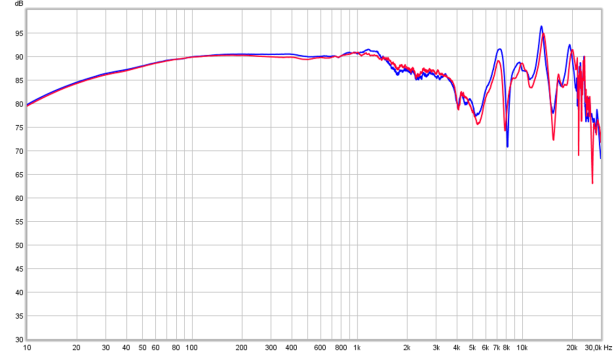
Channel matching is excellent. From 100Hz to 1.5kHz it is impressively neutral without any peaks or dips. There is a gradual roll-off below 100Hz which is audible as being slightly on the lean side of things. No thunderous bass here but nice and tight and very dynamic. The upper mids are somewhat recessed. The actual dip around 3kHz is probably slightly less then what the plot shows because of the lack of a Pinna and the drivers being angled. The 10dB dip at 5kHz is there though. It appears as though this is caused by the pads. This makes the mids to be lacking in clarity/presence. It removes the ‘details’ in instruments and voices.
The treble has a few narrow peaks and dips and above 20kHz some resonances.
The treble has a slight weirdness to it and some percussive things and other instruments can have an unnatural accent here or there and or some ‘sharp-ish’ edge to it.
It is quite detailed sounding though and not rolled-off or boosted sounding with plenty or ‘air’.
The Elear is the smaller and much less expensive sibling of the Utopia. Often they are mentioned in the same sentence. For this reason alone it stands to reason to compare them. Below the Elear and Utopia level matched in the mids.

Above 7kHz is is kind-off hard to see the average tonal balance differences between these 2 models. For this reason the same plot below but 1/3 octave smoothed.

What is obvious here is that from 10Hz to 1.5kHz these are exactly the same. Above 1.5kHz differences are clearer. The tonal balance of the Utopia shows more clarity/presence and a more realistic treble level. The average tonal balance of the Elear thus can be seen as ‘darker’ as in ‘less clarity’.
output resistance / damping-factor
As this is a dynamic headphone the frequency response might be amplifier output resistance dependent when certain higher output resistance amplifiers are used.
To test this the headphone is measured via a low impedance amplifier (0.2Ω) and a high impedance amplifier (120Ω). On a higher output resistance amplifier the output level will be considerably lower. To compensate for this the amplifier is cranked up to the same level (at 1kHz) as the low impedance amplifier. This way the plots are overlay-ed and it is easy to see how the tonal balance changes.

As can be seen the tonal balance changes considerably when connected to a higher output resistance amplifier. You get about 5dB more bass and a slightly ‘fuller’ bass.
When you would like a little more bass (not sub-bass) you could connect this headphone to a higher output resistance amplifier. Of course the amount of bass boost depends on the value of the amplifiers output resistance.
For the most neutral sound the output resistance should be between 0Ω and 10Ω.
Below the distortion plots of the Elear : (only Right channel shown)
Note that this headphone was measured at ![]() where background noises were present in the demo room. As this is an open headphone distortion levels and spectrum plot performance may thus be better in reality than as shown on the plots.
where background noises were present in the demo room. As this is an open headphone distortion levels and spectrum plot performance may thus be better in reality than as shown on the plots.
The distortion products are shown in dB.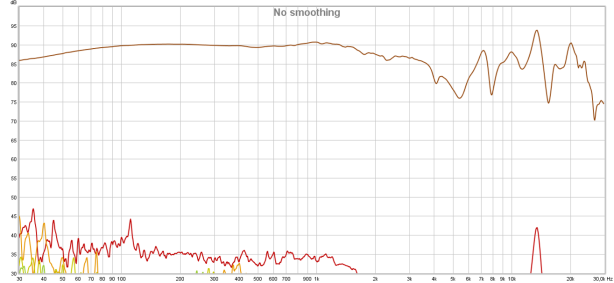 The distortion is very low, most certainly for a medium sized dynamic driver.
The distortion is very low, most certainly for a medium sized dynamic driver.
If only all headphones could perform this well !
Distortion levels in the bass below 0.2% is phenomenal. No distortion peaks above 2kHz at all.
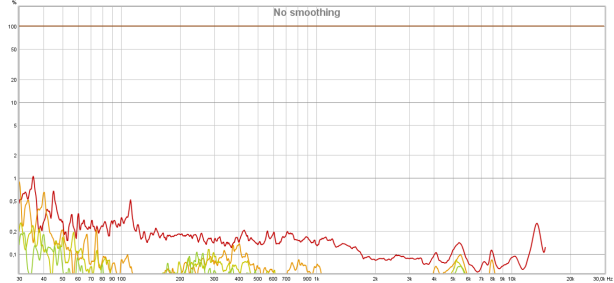
Below the CSD of the Elear (Left and Right channel are superimposed)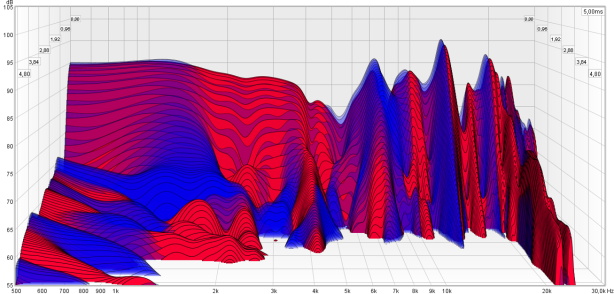
The CSD shows a very well controlled behavior up to 1kHz. At around 4kHz there is some short lived ringing. At this frequency this isn’t a problem as the ear canal resonates around that frequency as well. At around 13kHz there is a more obvious resonance. Not only the amplitude peaks there a bit too much but ringing is also longer. Above 20kHz the metal dome shows considerable ringing. It is above the audible range for the majority of those that would be enjoying this type of headphones. Nonetheless it does show some issues with the metal dome construction.

Above the CSD but now from a (0.2Ω) and a high impedance amplifier (120Ω). The interesting thing here is that while the frequency response doesn’t show any influence yet at 500Hz the headphone does ‘ring’ longer at that frequency.
Below the spectrum plot of the Elear (Left channel)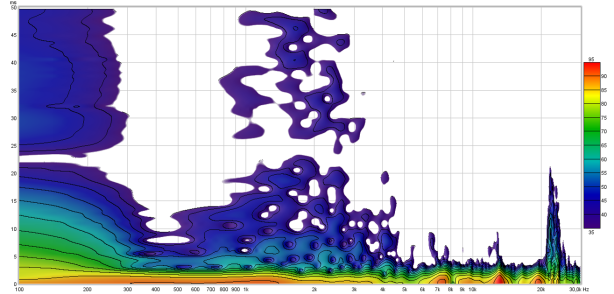
The ‘noise’ in the mids is (most likely) picked up from the room (around 40-45dB SPL) because this is an open headphone. Aside from some small issues around 7kHz and 13kHz the plot seems fine. Well when we ignore the resonances above 20kHz. When you are of the opinion that ‘somehow’ we can hear above 20kHz (cause Hires sounds so much better to you) then maybe the ringing there would have to be considered as less benign.
I suspect the ‘edge’ this headphone shows sometimes is explained by the 7kHz and 13kHz issues rather than the >20kHz ones.
By lack of oscilloscope shots (not enough time to measure that) below a step response plot of the Elear (Right channel)
The step response clearly shows the lack of ‘body/grunt/bottom end’ as evidenced by the downwards sloping horizontal line. There is no overshoot followed by some small level ringing at various frequencies. The small ‘oscillations’ that are visible after 1.5ms is the >20kHz ringing.
It is pointless to show the Left channel as it is measuring similarly.
summary
This headphone is top notch when it concerns build quality and feel. The cable is an abomination to me.
Others may like a 3m long stiff garden-hose connected to their headphones though .. a matter of taste perhaps. The weight may possibly be an issue for some people. The fit however is nice and doesn’t feel as heavy on the head as some Audeze headphones for instance.
It’s all about the sound though. This is a very dynamic and ‘open’ sounding headphone. For the retail price I would look elsewhere. When money is less of an issue the Utopia is the better one but forking out a factor 4 may not be an option for many people.
The (slight) lack of sub-bass/’grunt’ may not be an issue for most people. Bass is nice and tight. The ‘clarity/presence’ dip may also be welcomed by some, others are quite likely to complain about it. The weird/sometimes sharp-ish accents some instruments show may be the biggest issue (combined with the clarity issue).
My advise when thinking about buying this headphone is to try to audition (with it your own music, not demo music from the shop) OR make sure you can send it back after trying it for at least a few days.
This headphone ‘impresses’ immediately but the ‘negatives’ may take a bit longer to reveal themselves.
